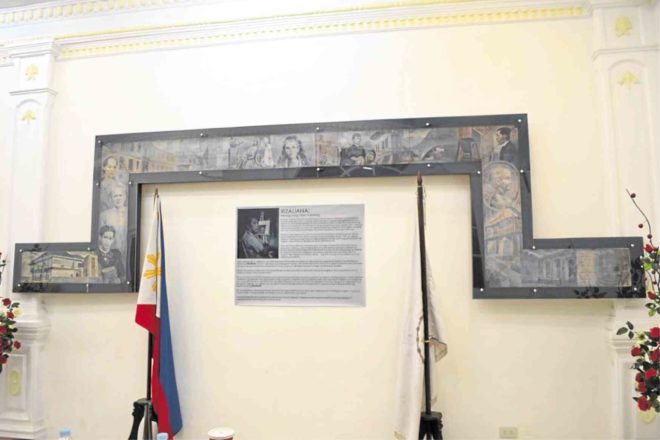
A rare painting by National Artist Carlos “Botong” Francisco has been discovered in Angono, Rizal.
The art piece titled “Rizaliana” was recovered by the newly created Angono Cultural Heritage Office (Acho) from the wall of the canteen of Don Joaquin Guido Elementary School.
“Rizaliana” depicts the life of José Rizal from his childhood in Calamba, Laguna, to his last days in Fort Santiago, Manila.
Acho head and Far Eastern University professor James Owen Saguinsin told the Inquirer the painting was done for free by Francisco for Angono Pilot Elementary School (now Angono Elementary School Central) in the late 1950s.
Public art
He said it was mounted in the library of that school together with paintings by other local artists José “Pitok” Blanco and Vicente Reyes and with escayola sculptures of heroes by Francisco Senson.
Botong’s work was moved to Don Joaquin Guido Elementary School in front of the central school after the latter’s library was damaged by a tropical cyclone in the 1980s.
Blanco’s and Senson’s works remain at the central school while Reyes’ was lost, possibly stolen.
Saguinsin explained that the teachers at the Don Guido school were unaware of the painting’s significance, it was mounted on a wall of its canteen.
During the school’s renovation in the ’90s, the work was found in the trash bin and saved twice by a teacher named Ruben Medina who placed it in his classroom, said Saguinsin.
Medina later picked it up again from the trash can after it had been thrown away once more by ignorant teachers and janitors, the FEU professor said.
Medina, now retired, then placed the painting, which measures 10 x 238 inches, as borders for his blackboard from where it was recovered recently by Acho officers with the permission of the school principal.
“Rizaliana” is one of only two major works of public art done by Francisco that still exist in Angono, the other being the painting of Our Lady of Perpetual Help in the town’s church, explained Saguinsin.
Iconography
The painting starts with the Rizal family house in Calamba, Laguna, depicted by the house reconstructed by National Artist Juan Nakpil in 1950.
Then, the images of a young Rizal and his parents Francisco Mercado and Teodora Alonso is presented, followed by the representation of his education through a school building which could probably be the old University of Santo Tomas building in Intramuros. (Botong himself became a faculty member of the fine arts department of UST in the mid-20th century with Victorio Edades and Vicente Manansala.)
Next is an image of a ship which represents Rizal’s travels, a portrait of a lady relating to the women he loved, an image of his novel “Noli Me Tangere,” and depictions of his return to the country from Spain and eventual exile to Dapitan in Zamboanga del Norte.
Botong’s work ends with the old Spanish military barracks, now the Rajah Sulayman Theater in Fort Santiago, and the lines from Rizal’s last work, “Mi Último Adiós.”
“Rizaliana” is a presumed important cultural property under Section 5b of the National Cultural Heritage Act of 2009 since it is a work done by a National Artist.
Hence it is protected by the same law against exportation, modification and demolition.
The local government however considers it as a “local treasure” that will be protected and preserved.
It now hangs at the mayor’s office while the Angono government tries to determine where it could be permanently displayed. —CONTRIBUTED